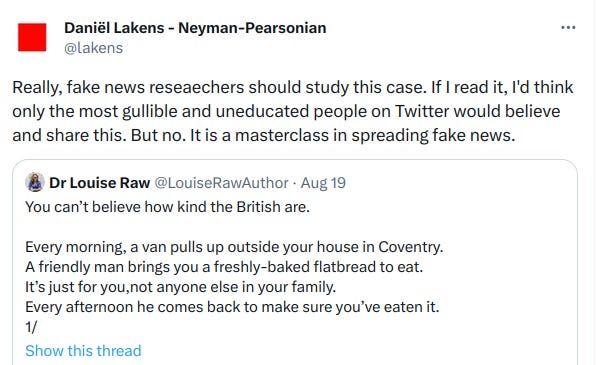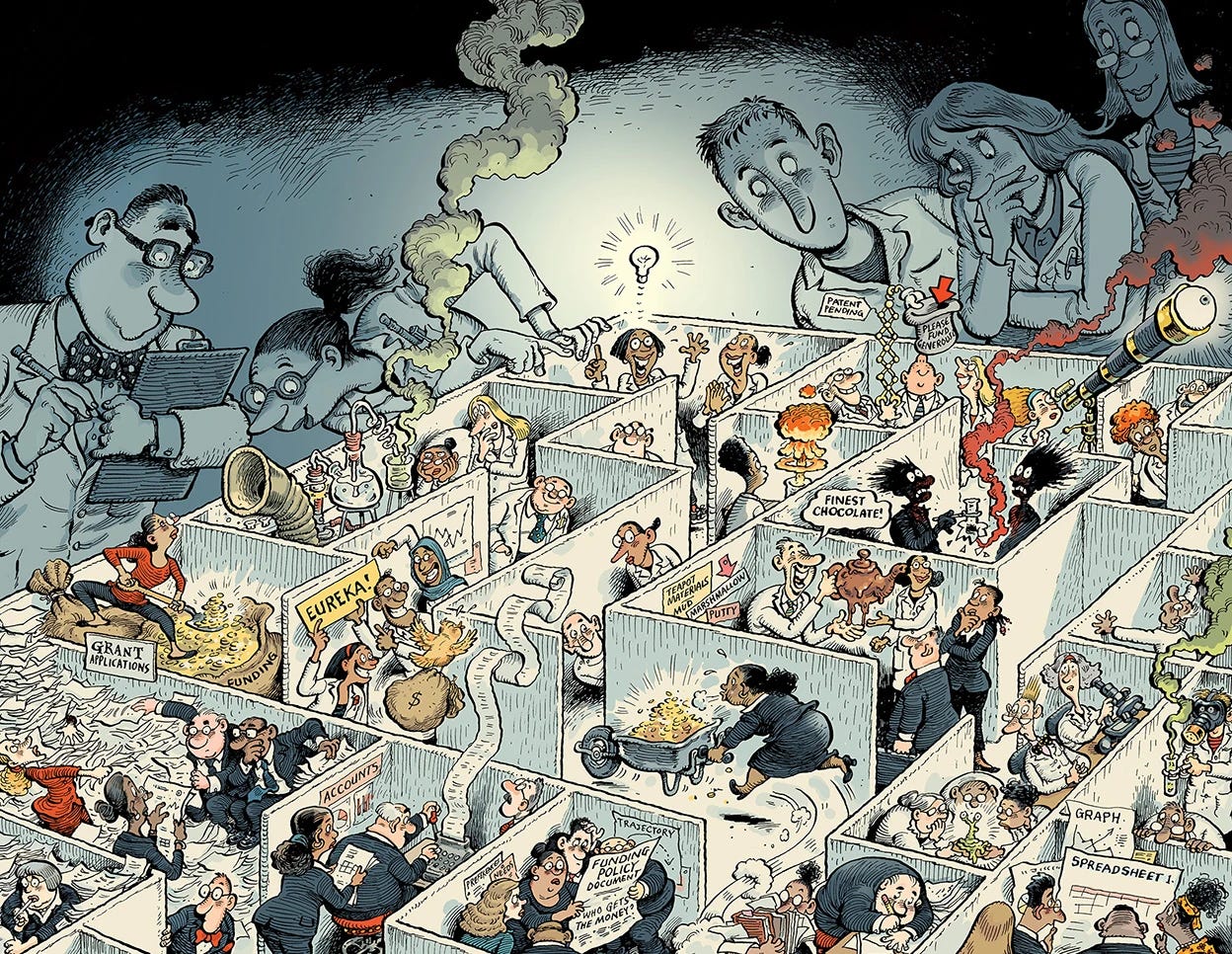Radiation-laced chapatis as a test case for defining Conspiracy Theories
Reasonable People #45: When is news obviously fake? And can Conspiracy Theories be defined, or is the term just one of abuse?
My first mistake was logging into twitter.com.
True to it’s reputation, The Algorithm immediately served me up a enraging thread on experiments on the effects of radiation, experiments in which unconsenting pregnant women were unknowingly fed radiation laced chapati in poorer parts of Coventry in the 1950s. Here’s the first tweet of the thread:
The full thread from @LouiseRawAuthor is here. The thread narrates the experience from the perspective of a participant, emphasising their lack of knowledge of what was going on. But what was going on?
We must have an enquiry into these illegal experiments, demands the thread. The lead tweet has 5.9M views as of the time of writing (almost exactly 72 hours after it was originally posted on 19 August). This, and the ~9k retweets/quotes and 18.5k favourites/bookmarks suggests many people agree that this is a scandal.
Fake News?
Here’s Daniël Lakens, who can be counted on for speaking his mind on topics psychological and statistical
And
His claim seems to be that this story is so patently ridiculous that only suckers would fall for it.
This interests me, because it is something I often hear about Conspiracy Theories; variations on “obviously that’s not true” or “you just know”. I’ve never felt it was obvious, or just known, and the longer I’ve tried to cleanly distinguish true from Conspiracy Theories, or real news from fake news, on some kind of surface feature the more sure I have got that there is no set of surface features which makes clean distinction. By design, fake news and Conspiracy Theories overlap in their surface features with the truth - they cite sources, are within the bounds of the possible (if not plausible) etc.
The bounds of the possible
When I read the radiation-laced chapati story it didn’t immediately trigger disbelief. Governments have experimented on citizens, especially ethnic minority, citizens without their consent (e.g the Tuskegee Syphilis experiment in the US which ended in 1972) and the history of science is littered with examples of unethical experiments and dubious treatment, particularly in psychology (lobotomies, electroshock, milgram, etc etc).
But there are a few warning signs that the truth may not be the way it is told here. The way the experiment is narrated makes it sounds like government scientists trawled the streets dishing out radioactive treats, poisoning people with nothing more than a perverse desire to find out what happened. That does seems a bit weird.
When I googled for the details of the story, I had a hard time finding more details. There were more hits - an article in the Independent, a post on Statewatch, a report on CND claims - but (warning sign!) all these appeared to reference the same source as the original thread - a 1995 TV documentary called Deadly Experiments by John Brownlow (YouTube link).
Digging further, it seems there was an enquiry. There’s a report, which is in the British Library at Boston Spa (not online, and currently unavailable since “in use by another reader”). There’s an abstract available via the INEA. Here’s the first half of that:
On 6 July 1995, a television documentary entitled 'Deadly Experiments' was broadcast on Channel 4 as part of the 'True Stories' series. The programme, produced by Twenty-Twenty Television, featured a number of research projects conducted between 1950 and 1970 in which either measurements were made of the amount of radiation absorbed by, or radioactive substances were administered to, human subjects in the UK and USA. The level of public concern generated by the broadcast and the implication of unethical practices in the conduct of some of the research sponsored by the MRC, has acted as the trigger for the MRC to establish this independent Committee of Inquiry. Its remit has been to clarify the facts surrounding the research and to examine issues of 'acceptability and consent in the context of the scientific and ethical standards of the period in, which the research was carried out.
The report goes on to mention some specific studies, with this line only relating to the Coventry study
The Coventry study in which women from the Asian community were asked to consume specially prepared chapattis in order to measure levels of iron absorption, with a view to investigating the problem of anaemia
The British Medical Journal reports ‘MRC cleared of unethical research practices’. Here’s the first part, cut off by the paywall:
Eight studies carried out in the 1950s and 1960s which entailed the use of radiation and in which the investigators were accused of exploiting and possibly harming those who took part have been deemed ethical by an independent Medical Research Council (MRC) inquiry, the same body that funded the research.
The MRC launched its inquiry into the radiation experiments after a Channel 4 documentary Deadly Experiments, broadcast in July 1995, raised concerns about the way this and other research had been conducted. The programme asserted that many people who took part in the studies, including pregnant women and Asian [cut here]
With a few extra minutes I managed to find the full, short, text via JSTOR. It contains frustratingly scant details of the study which drives the original thread.
Bounded rationality
At this point I bottomed out. I wasn’t going to go to Boston Spa to read the MRC report, and I’m not going to watch the documentary (partly because I don’t watch videos, and partly because I believe if there was any more substantive information on this study it would be in text somewhere), but even if I did press on - or even if I’d bottomed out earlier and been content to reason about the plausibility of this story based on the information in the original thread and my intuitions - I would still be in the same place, with my sanity in my hands and a hung jury. Without being there, how can anyone really know what happened? Can you trust the MRC to investigate itself? How can you decide on this case which doesn’t recruit prior expectations? Lakens says it is implausible, and the MRC says everything was in line with ethical standards for the time. I lean that way, but I recognise that this requires me to take the MRCs word for it. If I expected governments and government agencies to lie to me and perform perverted experiments then a locked away report from the 1990s would be no reassurance.
Here are a few other observations, which might have some general application to the topic of Conspiracy Theories and fake news:
Speculation thrives in an information vacuum. That the report on these experiments isn’t online, open access, can only drive the story as promoted in the documentary. It’s not enough for the MRC to have an enquiry, it should be available for us to read immediately the story surfaces again (and it will).
Rationality is about who you trust as much as how you reason. There’s always a point at which you have to stop digging, and take someone’s word for it. The decision about who to trust - the MRC or not; random posters on twitter or not - will pattern the conclusions you come to as much as the information or your research skills in seeking it.
The precise accusations are unclear, existing in strong and weak form, and this is encouraged by the format they appear in. The strong form, encouraged by the wording of the original thread, but not explicitly endorsed, is that government scientists used minority women as unwilling participants in experiments - exposing them to deadly radiation just to see what happened. The weak form is that, in the Coventry study, they struggled to achieve full informed consent for experiments which used radioactive materials, and for which more care should have been taken, and that this was part of a wider pattern of experiments in the earlier days of the study of radioactivity which reflects a systematic failure of care for experiment participants. Whatever the intention of the original thread, the popularity of the thread surely trades on it being interpreted in the more sensationalist form.
This could be an example of a leftist Conspiracy Theory. Last newsletter I wrote about Conspiracy Theories, and in particular Quassim Cassam’s attempt at a new definition of Conspiracy Theories as propaganda for ideologies, with particular defining features (speculative, contrarian, esoteric, amateur, premodern, self-sealing). In response to that post, a few people raised the issue of whether most Conspiracy Theories are right-wing, as Cassam implies, or if (as one commentator put) Conspiracy Theory is just a term of abuse meaning “non-leftwing account I don’t like”. The radiation-laced chapati story seems like a good test case. It was tweeted by a historian of labour activism, and found currency among academics (as evidenced by the reaction of Laken’s, who I am going to guess mostly follows researchers or research-oriented people, who tend to be leftist).
Is it a Conspiracy Theory by Cassam’s criteria? Arguably yes: it is speculative, in that it goes beyond what we can establish for sure (what were the chapati’s laced with? It could be anything from poisonous radiation - in the implied Conspiracy account - to irradiated salts - in the deflationary account). It is contrarian - counter the official conclusion from the enquiry. It is esoteric, maybe - this is the heart of Laken’s doubts: why would scientists want to test radiation poisoning on minority women, a hard to read and monitor population? It is amateur - the proponents don’t have any background in this topic. Is it premodern (meaning about wicked intentions of individuals or small groups)? Or self-sealing? I am not sure, but it is certainly propaganda for an ideology - and ideology that says that government and medical elites don’t care for minorities, and will cover up if caught out.
The story means Cassam’s criteria, which supports the idea that Conspiracy Theories are a real category, distinguishable from other kinds of accounts. That I haven’t seen anyone call it a Conspiracy Theory supports the idea that the term is also one disapprovingly used by leftists, but perhaps not sufficiently applied to leftist originating accounts.
PODCAST: Why people who are most likely to suggest that others “do their own research” are also the least likely to do their own research
Nicely related to today’s main topic, David McRaney interview with Sedona Chinn
Sedona Chinn, a researcher who studies how people make sense of competing scientific, environmental, and health-related claims, joins us to discuss her latest research into doing your own research. In her latest paper she found that the more a person values the concept of doing your own research, the less likely that person is to actually do their own research. In the episode we explore the origin of the concept, what that phrase really means, and the implications of her study on everything from politics to vaccines to conspiratorial thinking.
But in this abstract "do your own research” should have been in quotes, since it becomes clear that the injunction is a trope which is very much associated with a particular demographic (hence why it can mean both more and less that actually doing your own actual research).
And finally
David Perkin's illustration from this Nature article about metascience is so great
END
Comments? Feedback? Conspiratorial theories? I am tom@idiolect.org.uk and on Mastodon at @tomstafford@mastodon.online








Daniel does a better job than me of uncovering the original logic of these experiments http://daniellakens.blogspot.com/2023/08/reflections-on-viral-thread-by-dr.html
"a 1975 TV documentary called Deadly Experiments" - I think that should say 1995. I found it rather odd reading this article as I know both you and John Brownlow!